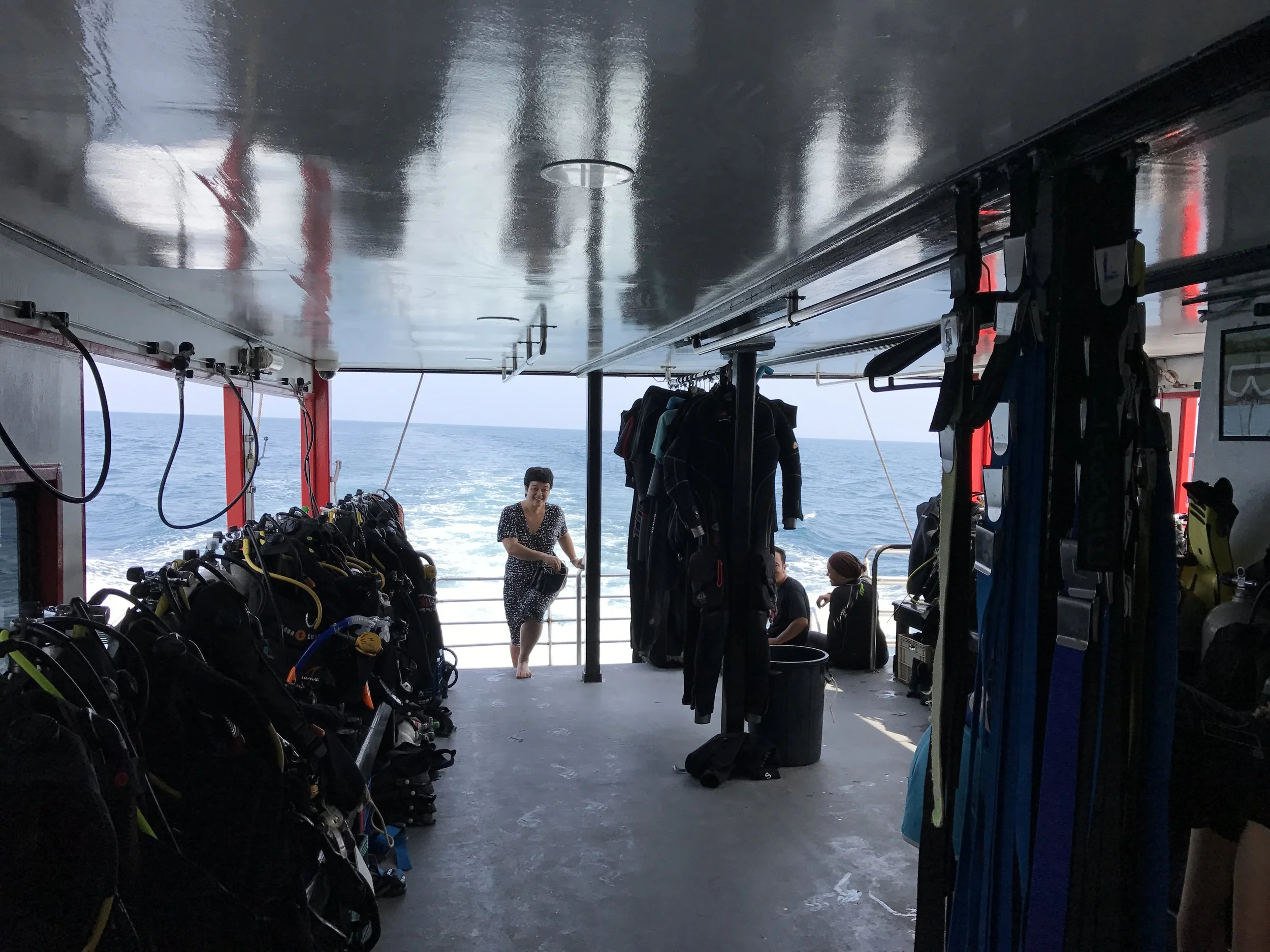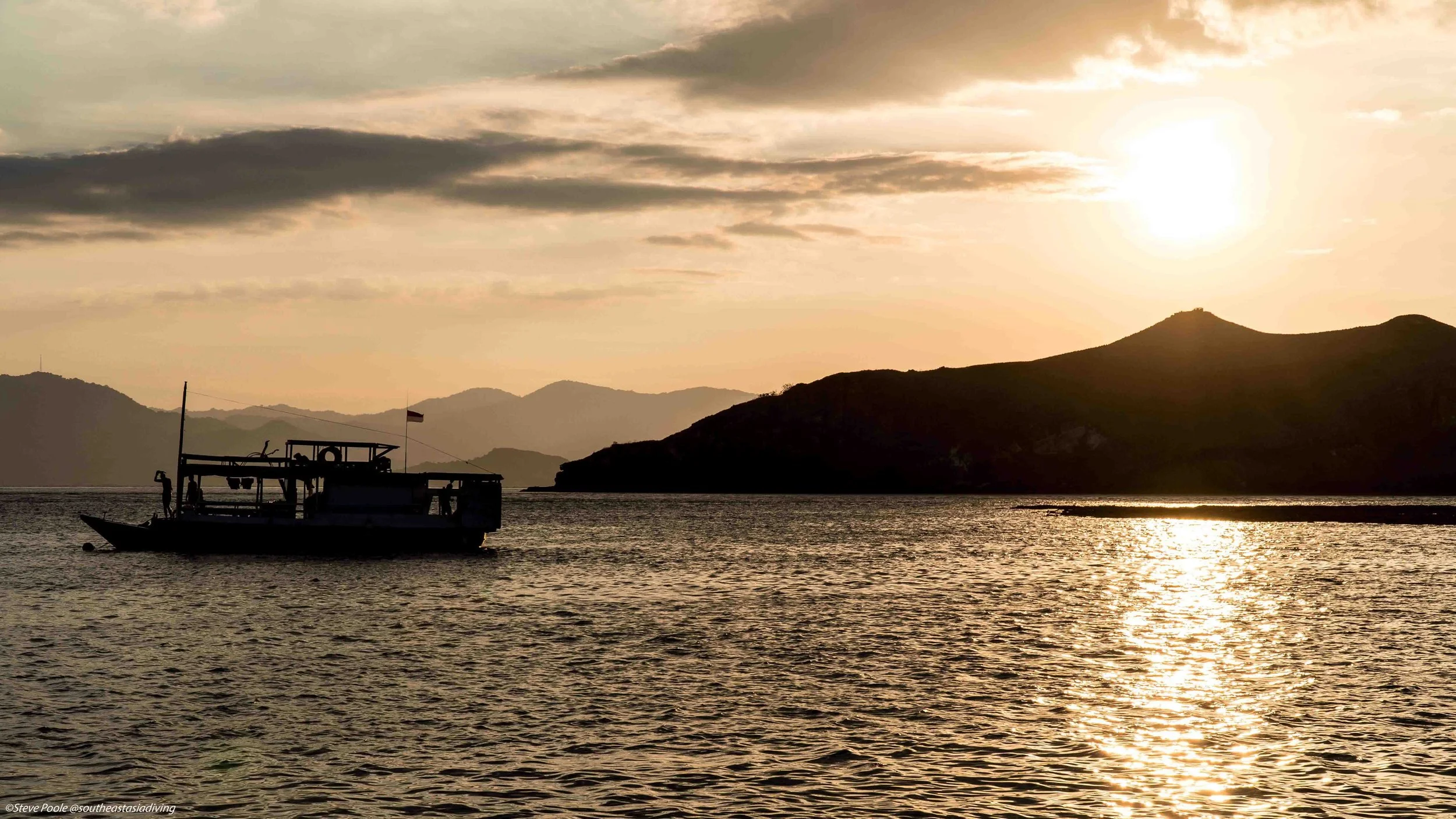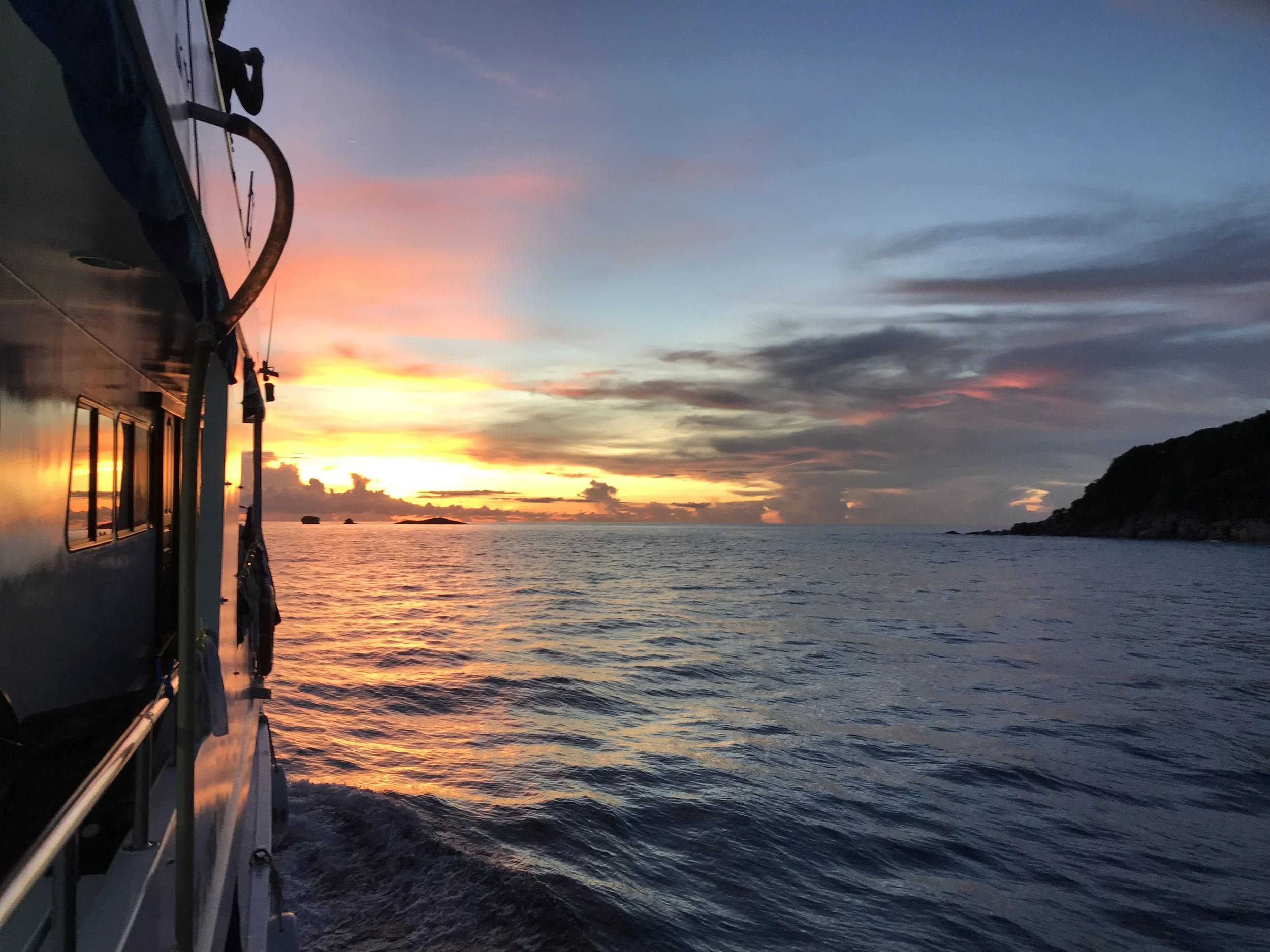🌏 Top 5 Liveaboard Diving Trips in Southeast Asia
Explore Raja Ampat, Komodo, the Similan Islands, Tubbataha, and the Mergui Archipelago
🐠 Introduction — Life at Sea, Beneath the Surface
There’s something almost meditative about life on a liveaboard — waking up to the sound of water lapping against the hull, sipping your morning coffee as the sun rises over the open ocean, and knowing the day ahead is filled with nothing but diving, exploring, and wonder.
Southeast Asia is home to some of the most biodiverse marine ecosystems on Earth, and many of its finest dive sites are accessible only by liveaboard. These floating dive resorts take you beyond the crowds and into untouched territory — where coral gardens stretch for miles, pelagics patrol the blue, and every dive feels like discovery.
Whether you dream of drifting through Raja Ampat’s kaleidoscopic reefs, chasing mantas through Komodo’s currents, or descending along Tubbataha’s remote walls, each destination offers something unforgettable.
Here are our Top 5 Liveaboard Diving Trips in Southeast Asia — routes that capture the very essence of exploration beneath the waves.
🪸 1. Raja Ampat, Indonesia — The Crown Jewel of the Coral Triangle
Why It’s Special
Raja Ampat — “The Four Kings” — is more than a dive destination; it’s a marine masterpiece. Nestled in the heart of Indonesia’s West Papua province, it boasts the highest coral and fish diversity on the planet. Liveaboards here unlock hidden corners of this vast archipelago — far beyond the reach of day boats — from the manta cleaning stations of Misool to the current-swept coral slopes of Dampier Strait.
Expect a sensory overload: schools of barracuda swirling above coral bommies, pint-sized pygmy seahorses camouflaged among gorgonians, and manta rays soaring through clouds of anthias. Every dive feels cinematic.
Best Time to Go
🗓️ October to April
During these months, seas are calm, visibility peaks, and plankton blooms attract mantas.
Photographer’s Dream
Raja Ampat is wide-angle heaven. A fisheye lens captures coral gardens glowing beneath the sun, while ambient-light photography reveals surreal blues in The Passage — the narrow waterway between Gam and Waigeo that feels like diving through a rainforest.
💡 Pro Tip: Spend a few extra days in Misool for night dives with walking sharks and bioluminescent plankton that light up the water like stars.
🦈 2. Komodo, Indonesia — Currents, Coral & Dragons
Why It’s Special
Komodo National Park is as fierce and fascinating underwater as it is on land. Its nutrient-rich currents feed reefs that explode with life — reef sharks, turtles, mantas, schooling trevally, and macro marvels. Liveaboards here explore both the warmer north and cooler southern sites, offering incredible variety.
Famous dive sites like Castle Rock, Batu Bolong, and Manta Alley deliver high-octane drifts, massive sea fans, and pelagic encounters that leave divers wide-eyed and breathless.
Best Time to Go
🗓️ May to October — calm seas and clear water.
💨 Strong currents = healthy reefs (and thrilling dives).
Photography Tips
Bring both macro and wide-angle setups. Wide-angle for mantas and shark passes; macro for frogfish, nudibranchs, and ornate ghost pipefish found in sheltered bays like Siaba Besar.
💡 Pro Tip: Some itineraries include Padar Island — where you can hike at sunset to one of Indonesia’s most iconic viewpoints between dives.
🪼 3. Similan Islands & the Andaman Sea, Thailand — Granite Giants of the East
Why It’s Special
Just off Thailand’s west coast, the Similan Islands are renowned for their massive granite boulders, vibrant coral reefs, and pelagic encounters. The underwater topography here is truly unique — think caverns, swim-throughs, and towering rock formations covered in soft corals.
Most liveaboards also visit Koh Bon, Koh Tachai, and Richelieu Rock, the latter famous for whale shark and manta sightings during peak season.
Best Time to Go
🗓️ November to May — the park is open, and conditions are calm.
During March–April, expect warm water and prime visibility.
What You’ll See
Schools of snappers, fusiliers, barracuda, and macro gems like harlequin shrimp and tiger cowries hidden in coral crevices. The contrast between granite, coral, and open blue water creates some of the most striking scenery in Southeast Asia.
💡 Pro Tip: Try a Similans–Surin combo route for a full Andaman Sea experience — 7–10 days of granite walls, soft corals, and pelagic action.
🐢 4. Tubbataha Reefs, Philippines — Remote, Raw, and Unforgettable
Why It’s Special
A UNESCO World Heritage Site and one of the world’s most protected marine parks, Tubbataha Reefs Natural Parksits in the middle of the Sulu Sea — 150 km from the nearest land. Only accessible by liveaboard for a few months each year, it’s one of the last truly untouched reef systems on Earth.
Expect dramatic walls, enormous coral formations, and an abundance of sharks — including grey reef, whitetip, and hammerheads. Schools of jacks and barracuda shimmer in the blue, while turtles cruise by effortlessly.
Each dive feels pristine, timeless, and humbling.
Best Time to Go
🗓️ March to June — calm seas and stable weather.
Only about 20 liveaboards have access, so trips book up fast.
Photography Tips
Bring wide-angle gear for sweeping coral vistas and pelagic silhouettes. The clarity of the water (often 30–40 m visibility) makes natural-light photography a joy.
💡 Pro Tip: Expect long open-sea crossings — pack seasickness medication, and enjoy some of the clearest night skies imaginable.
🐚 5. Mergui Archipelago, Myanmar — The Last Frontier
Why It’s Special
If you crave exploration far from the crowds, the Mergui Archipelago — just north of the Thai border — feels like stepping back in time. With over 800 islands, many uninhabited, this region is wild, remote, and stunningly diverse.
Dive sites like Black Rock, Shark Cave, and Western Rocky feature walls, swim-throughs, and pelagic surprises — from mantas and whale sharks to nudibranchs and harlequin shrimp. Coral gardens remain pristine, and you’ll often have entire sites to yourself.
Best Time to Go
🗓️ October to May — the dry season.
Water temperatures hover around 27–30 °C with visibility up to 25 m.
Photography Tips
Sunset over the Similan Islands, Thailand
Bring versatility. Macro for seahorses and frogfish, wide-angle for big scenes and dramatic rock formations. The contrast between soft corals and turquoise water makes for spectacular color compositions.
💡 Pro Tip: Liveaboards often depart from Thailand’s Ranong or Phuket, making this a perfect add-on after diving the Similans.
⚓ Choosing the Right Liveaboard
When choosing your trip, consider:
🕓 Season & Timing: Each destination has a distinct best window.
🧭 Experience Level: Komodo and Penida-style currents vs. calm Menjangan-like walls.
🛥️ Boat Style: From budget-friendly bunk cabins to luxury yachts with camera stations.
🌿 Sustainability: Choose operators following Green Fins, reef-safe practices, and marine park regulations.
💡 Pro Tip: If you’re a photographer, look for boats with dedicated camera rinse tanks and charging areas — you’ll appreciate the setup on longer expeditions.
🌅 Conclusion — Sail Into the Blue
Liveaboard diving isn’t just about ticking off sites — it’s about the rhythm of the sea, the simplicity of life aboard, and the privilege of exploring places where few ever venture.
Whether it’s the rainbow reefs of Raja Ampat, the thrill of Komodo’s drifts, or the solitude of Tubbataha’s open ocean, each trip offers a reminder of why we dive — for connection, for beauty, and for that indescribable feeling when the ocean swallows you whole and gives you peace in return.
So pack your dive log, camera, and sense of adventure — Southeast Asia’s greatest underwater journeys await.
❓ FAQ — Liveaboard Diving in Southeast Asia
1. What is a liveaboard dive trip?
A liveaboard is a floating dive resort — a vessel where you eat, sleep, and dive for several days. It allows divers to reach remote reefs and islands that are inaccessible by day boats, often with 3–4 dives per day and all meals included.
2. Do I need to be an advanced diver to join a liveaboard?
Not always! Some routes — such as the Similan Islands (Thailand) or Raja Ampat’s Dampier Strait — are suitable for beginners with Open Water certification.
However, destinations with strong currents like Komodo or the Mergui Archipelago are best for Advanced Open Water divers with drift experience.
3. What is the best time of year for liveaboard diving in Southeast Asia?
The region spans both hemispheres, so seasons vary:
Raja Ampat: October – April
Komodo: May – October
Similan Islands: November – May
Tubbataha (Philippines): March – June
Mergui Archipelago: October – May
There’s a perfect liveaboard destination for nearly every month of the year.
4. How long do liveaboard trips usually last?
Trips range from 3–4 nights (short Similan safaris) to 10–14 nights (expeditions through Raja Ampat or the Banda Sea). Most include 3–4 dives per day, night dives, and full board accommodations.
5. How much does a liveaboard cost?
Prices vary depending on region, boat class, and duration:
Budget: from around $200–300 USD per night
Mid-range: $350–600 USD per night
Luxury yachts: $700–1,000+ USD per night
These typically include food, tanks, weights, and dives — with park fees and equipment rental as add-ons.
6. What should I pack for a liveaboard?
Dive gear (if not renting)
Reef-safe sunscreen and biodegradable toiletries
Light clothing and swimwear
Seasickness tablets (for open crossings like Tubbataha)
A good book or journal for surface intervals
💡 Pro Tip: Pack a soft duffel bag instead of a hard suitcase — storage space is limited onboard.
7. Are liveaboard trips safe?
Yes — reputable operators follow strict safety protocols, have onboard oxygen and first aid, and employ experienced dive guides. Always check the boat’s safety equipment, emergency procedures, and recent reviews before booking.
8. What marine life can I expect to see?
Depending on where you go:
Raja Ampat: Mantas, walking sharks, and pygmy seahorses
Komodo: Reef sharks, turtles, mantas, and nudibranchs
Similans: Whale sharks and vibrant reef fish
Tubbataha: Hammerheads, schooling jacks, and turtles
Mergui: Seahorses, frogfish, and occasional whale sharks
Every liveaboard promises a different kind of magic.
9. How far in advance should I book a liveaboard?
For popular routes like Tubbataha and Raja Ampat, book 9–12 months ahead — spaces are limited due to park permits. For others, 3–6 months is usually enough.
10. What makes Southeast Asia special for liveaboard diving?
Southeast Asia offers unparalleled biodiversity, tropical conditions, and year-round diving — all in close proximity. You can experience everything from coral gardens and macro life to drift dives and pelagic encounters, often within a single itinerary.



